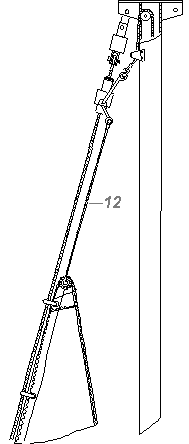Headsail furling Gear with Halyard Swivel for Wire Forestay
For Sails with Jib Hanks and Forestay length under 10m.
Note that while these diagrams are of masthead rig, the roller furling is easily adapted for Shark fractional rigs.
Simple sail change with the existing Halyard.
Advantages
- Halyard swivel (without sheave)
- Eye terminal
- Halyard swivel
- Halyard
- Halyard lead block/halyard lead eye
- Wire forestay
- Stopper bullet
- Turnbuckle
- Three hole plate
- Jib furler Endless ; Jib furler Standard
- Snap Shackle
- To the headsail furling gear with profiled luff stay and reefable sails.Sails with jib hanks can be further used – sail changing as usual
- The halyard can be released when changing the sails, because the halyard is fixed over the halyard swivel on the fore-stay
- Outer halyards or within the mast running halyards can be used
- The stopper bullet prevents the dogging of the jib hank on the terminal shank
- Extension possibilities
To the jib furler with profiled luff stay
Simple sail change – the bending an unbending of the jib hanks is not needed.
Improved flow of the sail through the profiled luff stay – the fore leech will be stabilized and will not hang between the jib hanks.
Tension on the jib halyard will be reduced.
The rig, the halyard and the fittings will be relieved.
In case of increasing wind hauling tight of the jib halyard will be spared and so also the loosening and tightening of the standard backstay.
Safe and quick reefing of the sail from the cockpit.
With deck passage as below deck gear (p. 31-33)
Safe and quick reefing of the sail from the cockpit.
The halyard swivel has to be constantly located close to the headstay swivel when sails are set otherwise the halyard can twist around the stay. Extend short headsails (e.g. storm jib) with a wire sling.For fore leech length over 10 m we recommend in general a profiled luff stay, otherwise the fore leech will be too strongly twisted when furled.
12 Wire sling extension for short headsails
The fore leech length of the sails and respectively the wire sling are to be dimensioned in such a way that the halyard swivel doesn’t touch the top eye terminal, even when the jib halyard is strained.
Between stay and halyard an angle of at least 15° degrees has to be observed, otherwise the halyard can twist itself around
Corrective measures: the stay.
(Take note of the class regulations)
- Mount halyard lead block on mast
- Set halyard outlet low (sheave box circa 200 mm under the stay)
- Alternatively the halyard can lead out of the mast circa 0,5 m over the stay.


